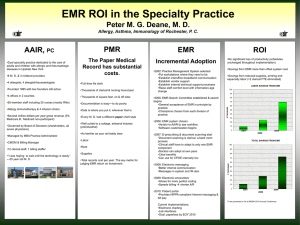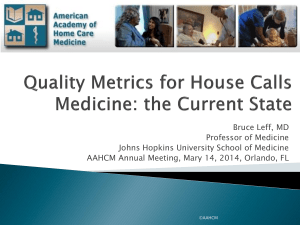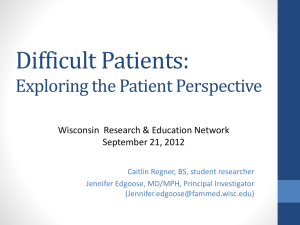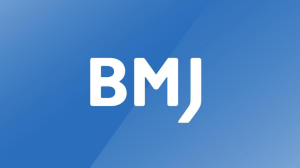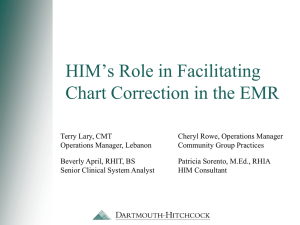1. Participants and Methods
advertisement
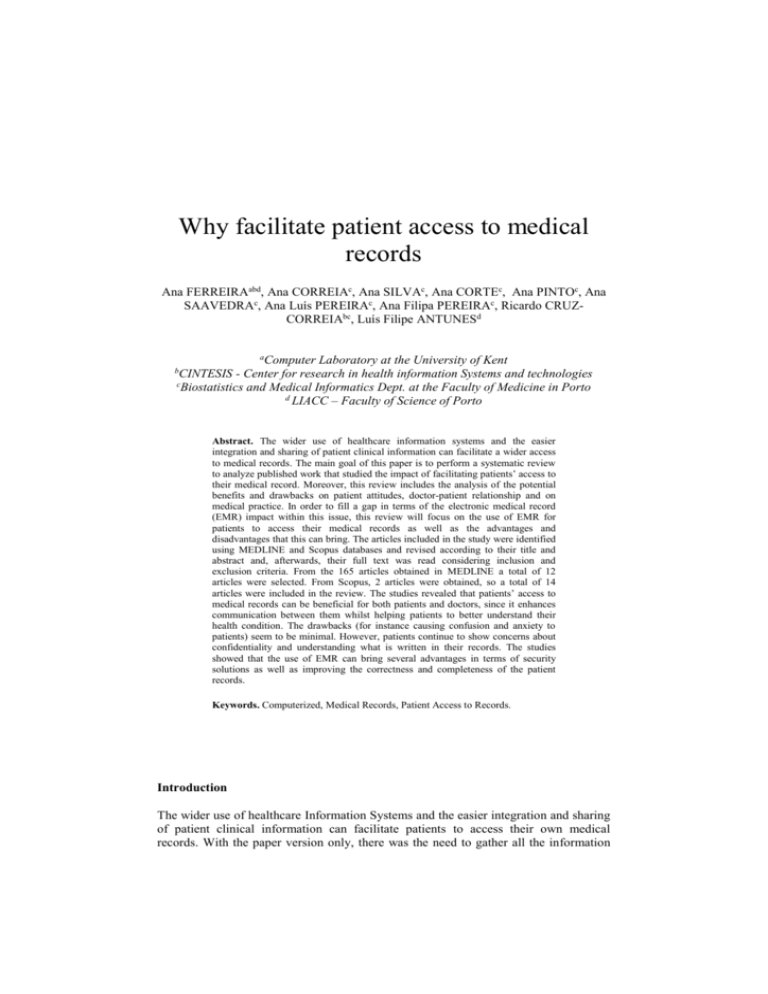
Why facilitate patient access to medical records Ana FERREIRAabd, Ana CORREIAc, Ana SILVAc, Ana CORTEc, Ana PINTOc, Ana SAAVEDRAc, Ana Luís PEREIRAc, Ana Filipa PEREIRAc, Ricardo CRUZCORREIAbc, Luís Filipe ANTUNESd a Computer Laboratory at the University of Kent CINTESIS - Center for research in health information Systems and technologies c Biostatistics and Medical Informatics Dept. at the Faculty of Medicine in Porto d LIACC – Faculty of Science of Porto b Abstract. The wider use of healthcare information systems and the easier integration and sharing of patient clinical information can facilitate a wider access to medical records. The main goal of this paper is to perform a systematic review to analyze published work that studied the impact of facilitating patients’ access to their medical record. Moreover, this review includes the analysis of the potential benefits and drawbacks on patient attitudes, doctor-patient relationship and on medical practice. In order to fill a gap in terms of the electronic medical record (EMR) impact within this issue, this review will focus on the use of EMR for patients to access their medical records as well as the advantages and disadvantages that this can bring. The articles included in the study were identified using MEDLINE and Scopus databases and revised according to their title and abstract and, afterwards, their full text was read considering inclusion and exclusion criteria. From the 165 articles obtained in MEDLINE a total of 12 articles were selected. From Scopus, 2 articles were obtained, so a total of 14 articles were included in the review. The studies revealed that patients’ access to medical records can be beneficial for both patients and doctors, since it enhances communication between them whilst helping patients to better understand their health condition. The drawbacks (for instance causing confusion and anxiety to patients) seem to be minimal. However, patients continue to show concerns about confidentiality and understanding what is written in their records. The studies showed that the use of EMR can bring several advantages in terms of security solutions as well as improving the correctness and completeness of the patient records. Keywords. Computerized, Medical Records, Patient Access to Records. Introduction The wider use of healthcare Information Systems and the easier integration and sharing of patient clinical information can facilitate patients to access their own medical records. With the paper version only, there was the need to gather all the information into a single copy of the scattered medical record and patients had to obtain a formal authorization to access it [1]. According to the European legislation patients should be able to access their clinical information whenever they request and have means to control who can see and change that information [2]. However, this is still not common practice mostly because of logistic and also cultural issues. The general idea is that healthcare professionals think this may negatively affect their relationship with the patients whilst patients themselves do not know if they want to see their medical record and if they do, will it be helpful and will they understand it anyway. Nevertheless, nowadays, patient access to paper records can be fairly common in some places. Countries like United Kingdom, New Zealand, Canada and USA have enacted legislation to ensure patient access to health records [3]. In 1996, it was stipulated by the HIPAA Act (Health Insurance Portability and Accountability Act) in the USA that patients must be able to access and get a copy of their medical records and correct them as needed [4]. Apart from some disadvantages already mentioned, Ross et al.[1] describes that patient access to medical records can facilitate doctor-patient relationship by enhancing doctor-patient communication, which allows the flow of information among them and helps reducing errors and improve quality. However, it can, at the same time, undermine the trust and so harm doctor-patient relationship. If, on one hand this access can potentially bring some effects on the patients like improving satisfaction, autonomy or self-efficacy it can, on the other hand, cause confusion and anxiety [1], [5]. Outside the health care sector, personal health records can influence many aspects of life, such as obtaining employment, life insurance or consumer credit [3]. The example of a scenario done within the UK NHS (National Health Service) introduced the opportunity of patients to get copies of their referral letters [6]. Although White et al [6] claims that there has been little empirical research done in this area, with this case they expect patients to better understand their situation as well as improve doctor-patient relationship and the quality of medical information. A review done in 2003 of published material that analysed the effects of promoting patient access to medical records concluded that the revised material consistently showed that it enhances doctor-patient communication [1]. Further, the patient satisfaction is high compared with very few records that found that patients were upset with what they saw. This same review also indicated that the future is likely to involve EMR and future research will show if this technology will influence positively or negatively patient satisfaction, understanding or any other factor that would affect healthcare. Although EMR may be able to facilitate the access to clinical information by the patients the fact that it is sometimes fragmented across multiple treatment sites can pose an obstacle to clinical care, research and public health efforts [7] as well as security [8]. The objective of this paper is to perform a systematic review to analyze published work that studied the impact of facilitating patients’ access to their medical record. Moreover, this review includes the analysis of the potential benefits and drawbacks on patient attitudes, doctor-patient relationship and on medical practice. In order to fill a gap in terms of the EMR impact within this issue, this review will focus on the use of EMR as well as the advantages and disadvantages that it can bring. The next section presents the methods used for the review while section 2 presents the most relevant results. Section 3 discusses those results and the last section gives some hints on what should be the trend to follow when facilitating or not patients’ access to their medical records. 1. Participants and Methods A systematic review based on articles written between 1990 and 2005 was performed. The dependent variable was the effects on medical practice and the independent variable was patients having access to records. The target population was adult patients and studies that gave parents access to paediatric records were excluded. The articles were identified using MEDLINE and Scopus. The resulting query used in MEDLINE was ("Medical Records Systems, Computerized"[MeSH] OR "Medical Records"[MeSH]) AND "Patient Access to Records"[MeSH] NOT (pediatric[All Fields] AND ("records"[MeSH Terms] OR records[Text Word])) AND ("1990"[PDAT] : "2005"[PDAT]). As more medical records are being computerized the mesh term Medical records systems, computerized was added to analyse the access to records through computers. The publishing type Review was excluded as well as the parents’ access to paediatric records, in order to focus the study in the impact of a patient reading their own records. In Scopus search, 3 queries were applied: ALL("Medical Records Systems") AND ALL(Computerized) AND ALL("Patient Access to Records") AND PUBYEAR AFT 1990; ALL("Medical Records Systems") AND ALL(computerized) AND ALL("Patient Access") AND PUBYEAR AFT 1990; and ALL("Medical Records Systems") AND ALL(electronic medical record) AND ALL("Patient Access") AND PUBYEAR AFT 1990. To increase the sensibility of the selection new rules were established. We included articles that analysed the effect of patients’ accessing their medical records and also studied the consequences on patients, health care providers, medical practice and doctor patient relationship. The articles referring to the access of medical records through electronic files were also included. The languages selected were English, Portuguese, French and Spanish. Excluded from this review were articles referring to specific cases that analysed the property of medical records, the patients’ rights, judging cases, identification of gametes donators and legal documentation. The articles were distributed by two groups of three people and each group read the titles and abstracts considering the established criteria. Figure 1 shows the method used to select the articles for the review. Figure 1 – Method used for the systematic review In a second step, the methodological quality of the articles was evaluated. In order to extract data from the articles we fragmented our main theme in 14 topics. Only 10 of these were explored: Patient Interest and Acceptance, Confusion and Misunderstandings, Patient Education, Creating Anxiety, Providing Reassurance, Promoting Adherence, Concerns about Confidentiality, Improving Doctor-Patient Relationship, Correcting Errors, The Use of Electronic Medical records. Each article had a grade between 0 and 22 based on 6 criterions. The criterions taken into consideration were: (1) Objective of the study - if it fully coincides with ours it should be given 14 points; 0 points if it has nothing to do with it; and 1 point for each topic it referred; (2) The kind of study – if it was a letter or an editorial it should be given 3 points; (3) Type of sampling – 2 points were given for a randomized sample and 1 point for a non-randomized; (4) Size of the sample – if the article studied a sample of [0-50] people it should receive 0 points and if it studied a sample with more than 50 people it would get 1 point; (5) Method used to collect data – if it was considered appropriated for the conclusions we wanted to achieve it was given 1 point otherwise it should receive 0 points; (6) Concordance between the results and the initial objective of the study (objectivity of the study) – if there was concordance it should be given 1 point and if there was not any concordance it should be given 0 points. After analysing all the articles and considering these criterions, we excluded the ones that received a grade inferior to 11. As there were not many scientific studies available for the studied theme we decided to include letters and editorials in the review. For these, the last four criterions did not apply, so they were given a grade between 0 and 17. If they had a grade superior or equal to 6 they were included. This means that a letter or editorial to be included had to mention at least 4 topics (Table 1 – Appendix). 2. Results 2.1. Search and selection of the articles From 165 articles obtained in MEDLINE search queries, 52 were selected after titles and abstracts were read. Then 22 full articles were found and analyzed considering the quality criterions explained in the previous section. From these 10 were excluded. A total of 12 articles were included from the MEDLINE search. On Scopus a total of 21 articles were obtained. From these only 9 were included and we managed to get 3 full articles. The quality criteria selected only 2. A total of 14 articles have been reviewed to write this paper. 2.2. Data extraction As described before, in order to extract data our main theme was subdivided in 14 topics. Figure 2 shows the number and type of article that mention each topic. 7 6 5 Transversal study Randomized Controlled trial Longitudinal study Letter 4 3 2 1 Ca EM ta us e of m en Th e cu do on s ct fe Ef g Fa cil ita tin R n ti o rs ro of n ct io re co r pa tie g Im pr us in g ov in g Im pr ov in at or -p ct do er ac isf sa t nt co m nt ie ab ns nc er tio n n tio ica un m fid on tc ou ts ou ab Co ns nc er lity e itiv en s g in ot om Pr Co en ti a en i te m s ce s ad he r tie pa in g er po w Em Pr ov id in g re ea tin as g su ra an xi nc nt e et y s nt ti e pa Cr at in g uc Ed co Pa nf tie us nt io s n in an te d re m st isu an d nd e ac rs ta ce p nd ta in nc gs e 0 Figure 2. Number and type of articles referring each topic The results presented in this section refer to only 10 of those 14 topics. The Effects on documentation, empowering patients, concerns about sensitive items and improving patient satisfaction were not analyzed. Table 1 presents the articles that mention each one of the topics. Table 1 – Number of articles that referred each one of the 10 studied topics No of Articles Topics Patient interest and acceptance Confusion and misunderstandings Patient education Creating anxiety Providing reassurance Promoting adherence Concerns about confidentiality Improving doctor-patient relationship Correcting errors The use of Electronic Medical Records YES 5 [5] [10] [12] [20] [21] 3 [15] [16] [21] 2 [4] [17] 1 [15] 2 [10] [17] 1 [7] 3 [4] [5] [17] 2 [4] [17] 1 [19] 8 [4] [5] [7] [9] [11] [12] [17] [21] NO 1 [14] 4 [4] [5] [10] [16] 1 [11] 1 [10] The following section describes in more detail the results obtained for each topic. 2.3. Patient experience with access to medical records 2.3.1. Patient Interest and Acceptance In a study with cancer patients, 91% of the patients declined the offer to see their medical records and the reasons given were: they trust totally on what the doctor had told them, they think that they knew enough or they would not understand it anyway [14]. The ones that inspected their medical records affirmed they did not obtain any new information and believed that any questions they might have could be answered by the clinical nurse or doctor. Although the situation referred above presents us a very strong percentage of people who refused the access to their medical records, the interest of patients in seeing their records is generally high [5], [10]. This is revealed by the answers of the patients that were asked about shared records in general, and about shared records online, in particular [20]. 95% of the patients agreed with the statement: “Overall, I think it is a good idea for patients to be able to routinely review their outpatient medical records”. It is also confirmed by this study that the interest was age dependent reducing steadily from 95% for those aged 21-30, down to 68% for those aged 71 and over. Most patients knew that they had the right to access their records and control those accesses although only 5% had actually accessed them. Some studies have demonstrated that patients’ interest in accessing their medical records was related with factors such as: general concern about health, independency of health status, interest in health information, concerns about patient safety, having a less trusting relationship with their primary physician and also the desire to be more involved in their own care [10], [21]. Ross et al. [11] showed that interest was not, however, health status or health care use related nor was it education or income related. This same study concludes that a vast majority of patients endorse the concept of patient-accessible medical records and about half support online access. This survey further demonstrates that these attitudes are shared even by patients in ethnically diverse and socio-economically disadvantaged populations. Focusing the access to the medical records via Internet, this study also revealed through a multivariate analysis that demographic features such as age, gender, race and education did not influence the interest in online patient-accessible records. The primary predictor was previous experience with the Internet, followed by expectations of the benefits and drawbacks of reading the medical record. Other studies have concluded that patients who have looked at their medical record in the past remain interested in reading it [10], [11]. Patients who did not know that they had the legal right to inspect their records were more than twice as likely to be very interested in reading their record [9]. Another aspect revealed was that women are more interested in accessing their medical records than men. Other findings were that patients were more interested in seeing their laboratory results followed by the physician’s notes [10], [12]. Patients were least interested in seeing past medication [10]. Most of the patients were interested in reading their medical record at regular intervals but not very frequently. 2.3.2. Confusion and Misunderstandings Some studies have revealed that incomprehensible jargon or pejorative comments will understandably confuse or distress the patients [15], [16]. This was an argument used many times in order to keep the medical records secret. Another study refers that patients of community health centers were more likely to be confused by various parts of the medical record and also embarrassed or offended by doctors’ notes, in comparison with academic primary care clinical patients [21]. 2.3.3. Patient Education The articles collected refer that in the majority of the cases an advantage to access the medical records is patients’ education. The access to the records helps patients to understand their health condition as well as what the doctor thinks [4], [17]. Patients who had access to their electronic medical records improved their own knowledge about their disease and increased the sense of ownership of their health care. This fact helped them to be more involved in their treatment and increased their ability to coordinate their care. It also allowed them to confirm the doses of medications and to provide laboratory results or medical information to other doctors. This has promoted patients’ sense of personalized support and capacity to look up their results [10], [12]. A disadvantage referred by some patients is the difficulty to understand medical records because of the use of technical language. 2.3.4. Creating Anxiety Although seeing their medical records can cause patients some anxiety or upsetting at times [15], recent studies and letters demonstrated that this is, in a vast majority of the cases, not true [4], [5], [10]. Recent experiences with patients who had access to their own records showed that doctors and patients considered the experience positive and did not cause any kind of anxiety or upset [16]. Psychiatric patients may respond less favourably than other patients. In spite of causing distress in a short term, in a longer term the access to records may be therapeutic. In a transversal study using adult psychiatric patients who had access to a written clinical summary about themselves, only 28% of the patients were upset with what they had read and 51% rated the written assessment as having provided helpful information [15]. 2.3.5. Providing Reassurance After reading and understanding what their doctor wrote about their health treatment the patients felt more reassured about their disease or health condition [10]. Patients felt reassured and more relaxed because their records gave them clear ideas about their health condition [17]. 2.3.6. Promoting Adherence In agreement with an American study based in the analysis of the American legislation about this theme, the simple fact of opening access to medical records can improve patients’ adherence to treatment, the efficiency of the service and strengthen the role of the profession [7]. A descriptive article about adherence shows that patients’ interest in viewing records increases after one interview which explains the objectives or the consequences of that access. In these cases, patients change their life style. They try to be more careful in order to follow medical recommendations. However, a randomized controlled trial study revealed that the access to an informatics’ program that provides patients’ access to their clinical notes did not result in any significant differences in their health status, clinic visits or hospitalizations but increased in 31% the messages sent to the system. The patients can have more interest in accessing their medical records but that does not mean that they will, most of the times, change their way of life [11]. 2.3.7. Concerns about confidentiality When patients were questioned about electronic access to their medical records they were worried about the security of some sensitive items. Although they find the inclusion of these items appropriate, they also think that they could be identified by a code [5]. In a randomized controlled trial several individuals voiced theoretical concerns about the security of their online records and were particularly concerned that their records could become available to employers or government agencies without their permission, although many did not mind sharing the records with close family members [17]. In another study, 24% of the patients expressed concerns about the confidentiality of their medical records which included the ability of others to get into the system where the health records were available. They did not trust the staff people and did not know how the system worked, which caused insecurity [4]. 2.4. Effects on Doctor-Patient Relationship 2.4.1. Improving Doctor-Patient Relationship In a transversal study, over 75 % of the respondents stated that having access to their notes would break down the barriers between them and the doctor and give information which one was not sure about. Over 70% felt it would give them more confidence in the doctor and over 65% felt it would help them to understand their condition and feel that their doctor understood them. 67% of the patients disagreed that it would give them less confidence in their doctor [4]. In another study the majority of patients and doctors were unanimous in their belief that the impact of the access to electronic health records was positive for both and improved the level of communication between them [17]. 2.5. Effects on Medical Practice 2.5.1. Correcting Errors Although patient accessible medical records offer them the opportunity to correct errors within the record, patients may also introduce errors if they make unauthorized additions or deletions to the medical record. The utility of auditing and of patients being able to correct their computer held records has been shown in several studies, including studies of administrative records in hospitals, outpatients clinics and general practice. In general practice, 24% of the patients said that there were mistakes, 30% found omissions within their medical record including allergies, dates of birth, addresses, current drug treatments, items on the problem list, smoking details, height, weight, alcohol history and family history [19]. 2.6. The Use of Electronic Medical records In eight of the fourteen selected articles the patients were given access to their electronic medical records [4], [5], [7], [9], [11], [12], [17], [21]. In some randomized clinical trials patients and doctors were given access to health records through the internet and electronic systems [11], [12], [17]. In the end, the majority of patients and doctors found this kind of systems easy to use, useful and considered that it can improve their communication with health care providers and their health care quality. In another randomized clinical trial the patients were given access to their electronic records in the waiting room through a secure access system that used fingerprint recognition technology [4]. When these patients were asked how interested they were in seeing their electronic records, a mean of 8.05 was obtained (in a scale of 0 to 10). Some of the patients said why they were interested on accessing electronic records: “not taking up anyone’s time”, “no bother for anyone” and “can just come in and sit down (at the computer)”. 41 patients were asked if they were interested in looking at their electronic records over the internet: 18 said they were very interested and 14 not interested at all. Some of them even added the comment: “do not think it should happen at all”. 56% of the patients agreed with the statement “Overall, I think it’s a good idea for patients to be able to review their outpatient medical records using the Internet”, meaning that about half of the patients support online access [21]. This study also concluded that previous experience with Internet, expectations of the benefits and drawbacks of accessing their medical records were the primary predictors of an interest in online patient-accessible records. In another study, patients were divided in terms of the preferred mode of access to medical records: through a paper copy of their medical record (49.3%) or through an electronic version at a secure, private web site (43.8%) [10]. In an editorial was said that by allowing patients interaction with the EMR physicians have much more accurate and up-to-date information for managing therapy [20]. However, there are still certain problems with access that must be overcome, such as ensuring privacy of personal medical data and determining the ways in which patients should be able to influence their charts. 3. Limitations Our review presents some limitations such as: not all the studies included in the review were randomized trials and, in general, their sample size was small. Most studies did not use standardized methods and the number of full articles found to include in the review was not very high. As the number of scientific articles found was quite reduced, we decided to include letters and editorials, which usually do not comprise the quality of a scientific study. 4. Discussion Overall, the studies revealed that patients’ access to medical records is beneficial both for patients and doctors, since it enhances communication between them whilst helping patients to better understand their health condition. Accessing medical records has also shown improvements on patients’ education, a better knowledge of the disease and more participation in their health treatment. Improvements on adherence made patients more careful in following medical recommendations and provided for self-empowerment. It allowed them more autonomy and self-efficacy by increasing a sense of ownership to their medical records. However, patients find some parts of the medical records difficult to understand because some notes are unintelligible or illegible to them. The access to medical records helps correcting errors and omissions but patients can also make unauthorized additions or deletions. The use of EMR can facilitate this process, so patients’ actions on their medical record must be ruled, monitored and controlled. The EMR raises several concerns about the security of sensitive items and confidentiality of the records. Some suggest the use of codes to identify sensitive items. As for confidentiality the possibility that technology gives for using security or any other security device reassures patients. The use of EMR also implies previous technological knowledge, which can be a problem, especially for older people. Nevertheless, the EMR makes it possible to solve some of the problems concerning the access to medical records, such as understanding doctor calligraphy. It can also reduce data errors by increasing the opportunities of patients to access their medical records as well as providing mechanisms to control the access, validate and correct information. 4. Conclusion Most patients and healthcare professionals seem to be unanimous in their belief that the impact of patients’ access to their medical record is positive for both. Not only are there some real benefits in the patient accessing his/her medical record but also new technologies can help improving and supporting this access. We agree that the EMR can bring some security solutions as well as the possibility of improving both the quality and completeness of the record allowing, therefore, for better treatment and trust in healthcare by the patients. This review stresses the importance and need for this kind of study to be further pursued and done in a regular basis. It can also be used as a future platform for research in this area. Acknowledgements We would like to thank class 2 of the 1st year medical students from the 2005/2006 academic year at the Biostatistics and Medical Informatics Department of the Faculty of Medicine of Porto for their work and enthusiasm in the development of this project. References [1] [2] [3] [4] Ross SE, Lin CT. The effects of promoting patient access to medical records: a review. J Am Med Inform Assoc 2003 May-Jun; 10 (3):294 Recommendation No. R (97) 5 of the Committee of Ministers to Member States on the Protection of Medical Data. Council of Europe – Committee of Ministers. 1997. Carter M. Should patients have access to their medical records? Med J Aust 1998; 169:596-597 Honeyman A, Cox B, Fisher B. Potential impacts of patient access to their electronic care records. Inform Prim Care. 2005;13(1):55-60. [5] [6] [7] [8] [9] [10] [11] [12] [13] [14] [15] [16] [17] [18] [19] [20] [21] Pyper C, Amery J, Watson M, Crook C. Access to electronic health records in primary care - a survey of patients’ view. Med Sci Monit, 2004; 10 (11): SR17-22. White P. Copying referral letters to patients: prepare for change. Patient Educ Couns. 2004 Aug;54(2):159-61. Mandl KD, Szolovitz P, Kohan IS. Public standards and patients’ control: keep electronic medical records accessible but private. BJM 2001 Jun 2; 322 (7298): 1368-9 Bakker A. Access to EHR and access control at a moment in the past: a discussion of the need and an exploration of the consequences. Int J Med Inform. 2004 Mar 31;73(3):267-70. Winkelman WJ, Leonard KJ, Rossos PG. Patient-perceived usefulness of online electronic medical records: employing grounded theory in the development of information and communication technologies for use by patients living with chronic illness. J Am Med Inform Assoc. 2005 MayJun;12(3):306-14. Epub 2005 Jan 31. Fowles JB, Kind AC, Craft C, Kind EA, Mandel JL, Adlis S. Patients' interest in reading their medical record: relation with clinical and sociodemographic characteristics and patients' approach to health care. Arch Intern Med. 2004 Apr 12;164(7):793-800. Ross S, Lin CT. A randomized controlled trial of a patient-accessible electronic medical record. AMIA Annu Symp Proc. 2003;:990. Cimino JJ, Patel VL, Kushniruk AW. The patient clinical information system (PatCIS): technical solutions for and experience with giving patients access to their electronic medical records. Int J Med Inform. 2002 Dec 18;68(1-3):113-27. Warden J. Patients to see medical records. BMJ. 1991 Sep 7;303(6802):538. e. Rostom AY, Gershuny AR. Access to patient records. Lancet. 1991 Nov 23;338(8778):1337-8. Bernadt M, Gunning L, Quenstedt M. Patients' access to their own psychiatric records. BMJ. 1991 Oct 19;303(6808):967. McLaren P. The right to know.BMJ. 1991 Oct 19;303(6808):937-8. Earnest MA, Ross SE, Wittevrongel L, Moore LA, Lin CT. Use of a patient-accessible electronic medical record in a practice for congestive heart failure: patient and physician experiences. J Am Med Inform Assoc. 2004 Sep-Oct;11(5):410-7. Epub 2004 Jun 7. Jones R, Cawsey A, Bental D, Pearson J. How should we evaluate patient access to their own records? An example with cancer patients in Scotland. Stud Health Technol Inform. 2003;95:152-7. Jones R. Patient access to records must be acceptable to both parties. BMJ. 2001 Jun 2;322(7298):13689. Ross, S.E., Todd, J., Moore, L.A., Beaty, B.L., Wittevrongel, L., Lin, C.-T.Expectations of patients and physicians regarding patient-accessible medical records(2005) Journal of Medical Internet Research Tsai, C.C., Starren, J.Patient participation in electronic medical records(2001) Journal of the American Medical Association 285 (13), p. 1765 Appendix Table 1. Articles included with the Relevance/Quality criteria Articles AHIMA e-HIM Personal Health Record Work Group. Practice brief. The role of the personal health record in the EHR. J AHIMA. [4] Honeyman A, Cox B, Fisher B. Potential impacts of patient access to their electronic care records. Inform Prim Care. Waegemann CP. Closer to reality. Personal health records represent a step in the right direction for interoperability of healthcare IT systems and accessibility of patient data. Health Manag Technol. [9] Winkelman WJ, Leonard KJ, Rossos PG. Patient-perceived usefulness of online electronic medical records: employing grounded theory in the development of information and communication technologies for use by patients living with chronic illness. J Am Med Inform Assoc. [5] Pyper C, Amery J, Watson M, Crook C. Access to electronic health records in primary care-a survey of patients' views. Med Sci Monit. Hassol A, Walker JM, Kidder D, Rokita K, Young D, Pierdon S, Deitz D, Kuck S, Ortiz E. Patient experiences and attitudes about access to a patient electronic health care record and linked web messaging. J Am Med Inform Assoc. [10] Fowles JB, Kind AC, Craft C, Kind EA, Mandel JL, Adlis S. Patients' interest in reading their medical record: relation with clinical and sociodemographic characteristics and patients' approach to health care. Objective (14) Kind of study (3) Type of sample (2) Size of sample (1) Methods of data extraction (1) Objectivity (1) Total Exclusion/ inclusion 0 _ _ _ _ _ 0 E 5 3 2 1 0 1 12 I 0 _ _ _ _ _ 0 E 4 3 1 1 1 1 11 I 9 3 2 1 1 1 17 I 0 _ _ _ _ _ 0 E 5 3 2 1 1 1 13 I [11] Ross S, Lin CT. A randomized controlled trial of a patient-accessible electronic medical record.AMIA Annu Symp Proc. Jones TM. Patient participation in EHR benefits. Health Manag Technol. [12] Cimino JJ, Patel VL, Kushniruk AW. The patient clinical information system (PatCIS): technical solutions for and experience with giving patients access to their electronic medical records. Int J Med Inform. Hughes G; American Health Information Management Association. Practice brief. Patient access and amendment to health records. J AHIMA. Dyer C. Patient denied right to see medical records. BMJ. [No authors listed] What's in my record? Lancet. [13] Warden J. Patients to see medical records. BMJ. British Medical Association. Patients' rights to see records. BMJ. Jones R. Patient access to records must be acceptable to both parties. BMJ. [14] Rostom AY, Gershuny AR. Access to patient records. Lancet. [15] Bernadt M, Gunning L, Quenstedt M. Patients' access to their own psychiatric records.BMJ. [16] McLaren P. The right to know. BMJ. Reuler JB, Balazs JR. Portable medical record for the homeless mentally ill. BMJ. 8 3 2 1 1 1 0 16 I 0 E 5 3 1 0 1 1 11 I 0 _ _ _ _ _ 0 E 0 _ _ _ _ _ 0 E 1 2 _ _ _ _ 3 E 4 2 _ _ _ _ 6 I 0 _ _ _ _ _ 0 E 2 2 _ _ _ _ 4 E 4 3 1 1 1 1 11 I 5 3 1 1 0 1 11 I 7 2 _ _ _ _ 9 I 0 _ _ _ _ _ 0 E [17] Earnest MA, Ross SE, Wittevrongel L, Moore LA, Lin CT. Use of a patient-accessible electronic medical record in a practice for congestive heart failure: patient and physician experiences. J Am Med Inform Assoc. [18] Jones R, Cawsey A, Bental D, Pearson J. How should we evaluate patient access to their own records? An example with cancer patients in Scotland. Stud Health Technol Inform. Ross, S.E., Todd, J., Moore, L.A., Beaty, B.L., Wittevrongel, L., Lin, C.-T. Expectations of patients and physicians regarding patientaccessible medical records (2005) Journal of Medical Internet Research [20] Tsai, C.C., Starren, J. Patient participation in electronic medical records (2001) Journal of the American Medical Association 285 (13), p. 1765. [21] Kim, M.I., Johnson, K.B. Personal health records: Evaluation of functionality and utility (2002) Journal of the American Medical Informatics Association 8 3 1 1 1 1 15 I 5 3 1 1 1 0 11 I 9 3 1 1 1 1 16 I 7 2 0 0 0 1 10 I 3 3 1 0 0 1 8 E



